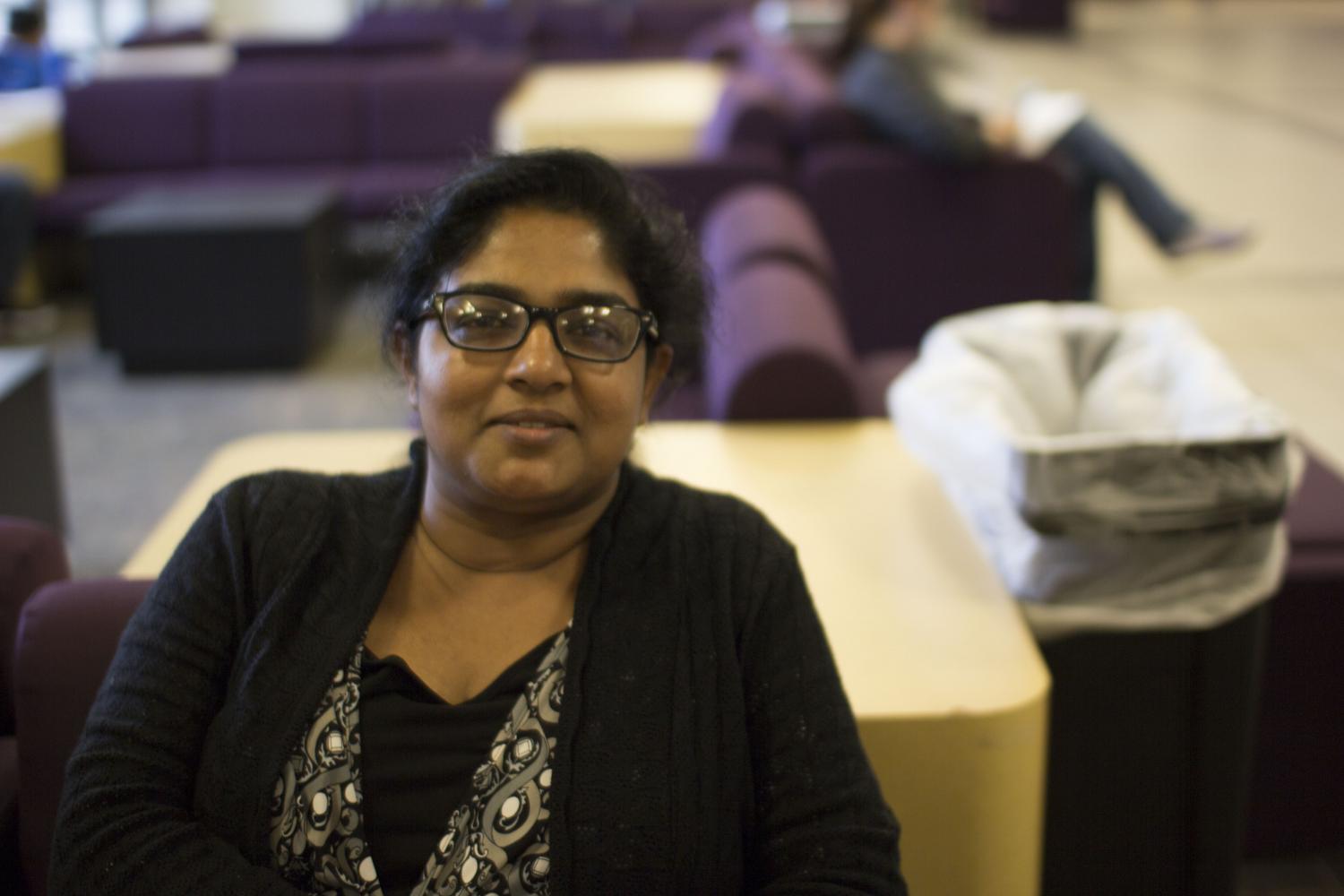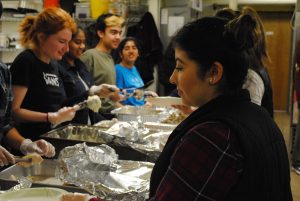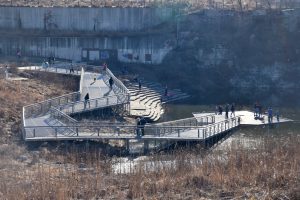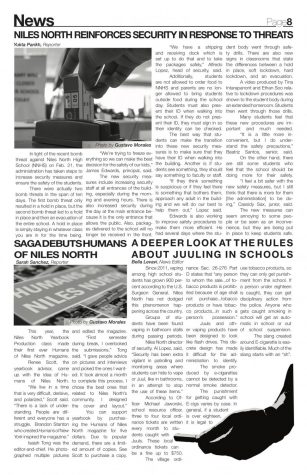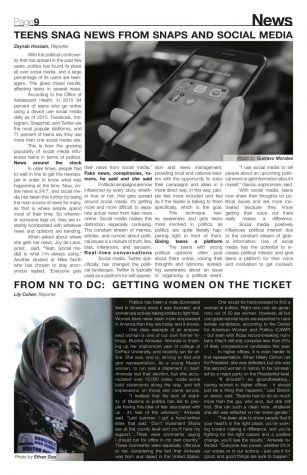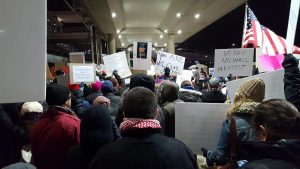Bella Carmela Levavi
May 22, 2017
This semester I focused on how to write like a real Journalist. While last semester, I only learned how not to throw my own opinions into the fact, this semester I have grown. I focused on how to give the news to the public in the most efficient way possible. I learned to interview the officials in school, I am now a regular at the principal’s office, and how to ask leading questions. Now my writing may be less interesting and less provocative than last year, but I finally understand how to only relay information.
I will be starting my journalism career at a time when media is constantly under attack by the President. This has taught me the importance of journalists going the extra mile to provide the public with honest information which is critical for the functioning of a democratic society. Journalists need to be willing to push boundaries to the point of being uncomfortable so that people can know the truth. Being an unbiased truth-seeking journalist is a way to be radical at this time.
Next year at Smith I will definitely use the skills I have learned in North Star. It has taught me how to love writing and how to work with a team. All the North Star staff has shown me what it means to be a community that can rely on each other. I now want to be a journalist in my future, and look forward to what college will bring me.
North Star News editors pick their favorite bops of 2017
The outcome of Janus v. AFSCME may hurt Niles North teachers
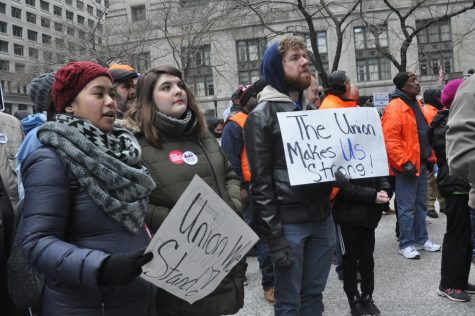
Feb. 24, Niles North teachers gathered at the Picasso statue in downtown Chicago for the Working People’s Day of Action to voice their opinion about the Supreme Court case Janus v. AFSCME.
Hundreds of people marched in the rally sponsored by more than 15 different unions and organizations.
Arguments were heard for Janus v. AFSCME on Feb. 26. Its outcome will determine whether unions can continue to receive fees for representation from employees who prefer not to be members. If the high court rules in favor of Janus, union dues will not be required to be paid by everyone in the unionized workplace.
Currently, if a person chooses to be a union member and pay full dues, a portion of the dues pays for political activities of the union. If a person does not wish for the union to lobby on their behalf, employees can pay a fee to the union to cover the cost for collective bargaining, not be a member, and receive the full benefits negotiated by the union.
Unions employ teams of researchers, lawyers, and skilled negotiators to advocate for the employees. Unions can afford to provide these expensive professional services because all of the employees contribute to cover the cost. If some workers are allowed to reap the benefits of collective bargaining without being required to pay for these services, the unions’ effectiveness will be weakened.
Janus’s attorneys argued before the Court that collective bargaining by the union is political speech, similar to lobbying. Under the First Amendment, the Court has ruled that no one can be compelled to pay for political speech with which they disagree.
William Messinger, representing the plaintiff Janus, argued before the Justices, “When the union collectively bargains with the government that is political speech.” If the Court accepts this argument, then it will likely rule that a union cannot force an employee it represents to pay for collective bargaining.
Without requiring workers to pay for the services provided by unions, unions will have fewer funds to pay for collective bargaining. The workers who do not contribute to the costs of the union will still benefit from any gains achieved through collective bargaining, and thus will be ‘free riders.’
Currently, union fees are deducted straight out of teachers’ paychecks at Niles North. If the Court rules in favor of Janus, then it will be harder to collect union dues because individuals who opt out, will no longer have their funds sent directly to the union.
Niles Township Federation of Teachers (NTFT) has 100 percent union membership in the district and only three people not paying full union dues.
Ann Goethals, president of NTFT, said, “The immediate fall out is not as bad for us [NTFT] than it will be for other unions. In the long run, it might be difficult, because if others see people getting the same benefits without paying union dues people may stop wanting to pay for them.”
If this Court case rules in favor of Janus, it will revise the ruling reached in the 1977 Supreme Court Case Abood v. Detroit Board of Education where the Court established the principle that individuals could not be made to pay union dues that go towards political activity, but could be required to pay fees that go towards collective bargaining (Oyez).
Spooky Season: College Application Edition
All through the month of October people like to be scared. Although, the scariest part of the month is not monsters, ghosts, or zombies, it’s collage apps.
Parents of Niles North
Niles North Parents met their children’s teachers on Sept. 7 at open house. This year North Star News and Saga are teaming up to make Humans of Niles North, this is the parent edition.
SOUP AT SIX: A NEW OUTLOOK ON SOUP KITCHENS
Soup at Six was started in 1983 by a group of six people operating out of the basement of a church on Clark Street north of Main. Relying on donations for its funding, the volunteers who run the kitchen work diligently every Tuesday to feed all who are in need. However, this soup kitchen has something special that sets it apart from its competitors in Evanston.
Erica Hall, the woman who runs the kitchen, is a retired chef from Belize. First thing every Tuesday morning she prepares an enormous feast for the guests that will come to eat that night. She is warm and friendly to all new visitors and volunteers. When asked why she has dedicated her energy to running the soup kitchen, Hall said, “I’ve fed people all my life; it’s what I love to do.” She prides herself on Soup on Six being the best soup kitchen in the area because of the high quality of the food, which she is happy to eat herself. Because of Hall’s dedication, the guests really notice and appreciate the care that goes into the food.
You can see the profound impact of this soup kitchen through the volunteer Terry Hammond. Thirteen years ago, Hammond was homeless as a result of medical issues and became a regular visitor to the soup kitchen. He was cared for by all of the volunteers and decided to become a volunteer himself. Now, every week he rides the Metra from the Southside of Chicago to Evanston so he can help serve. Hammond said, “What makes this place special is the volunteers. They make this a wonderful environment that supports the neighborhood. They never turn anyone away.”
One of the most outstanding volunteers at the soup kitchen is Bob. He is a tough man who drives a colossal pickup truck and goes camping every weekend, but he lives according to the philosophy that people have an obligation to help others. He understands that these homeless people are not only hungry for food, but also hungry for someone to care about them. He said, “Soup at Six is an organization with a meaningful purpose. This kitchen is not just a fly-by-night operation, it is helping people out for the long run.” He explained that just feeding the people isn’t enough. By getting to know them, he can get to the root of their problems, and then find help for them.
He notices people every week that have strange habits that others might overlook. One guest, Javier, asks for hot sauce every week. One may think that Javier just likes spicy food, but Bob understands that Javier likes to have something given to him for once; he feels cared for. This small gesture may seem trivial but Bob notices how much it means to the guests.
Another guest, Paulette, once came with poems she had written. Bob sat with her and read all of them. Listening to her made Paulette feel like someone cared for her. Bob’s consideration for all people makes him an admirable person. Everyone should care for the marginalized as much as he does.
Soup at Six is a special place because it provides more than just delicious food for the homeless; it provides an environment that gives support to all the visitors. In a world where the homeless are commonly overlooked, it is increasingly important to have places like this where they are given dignity and cared for. Everyone can learn a lesson from how this soup kitchen is run. While providing nourishment for people in need is good, caring for others is something that everyone needs to strive to do.
Featured image credits to Jasmine Gong
CHICAGO’S ICONIC PARKITECT: ERNEST WONG
“The commonality that all great cities have are its public spaces” said Ernest Wong.
Wong, of Site Design Group, designs innovative and creative parks across Chicago. He follows in the footsteps of his dad who was an architect trained by Mies Van de Rohe of Bauhaus and founder of the architecture school at IIT. These parks are in such diverse locations as Streeterville, the West Loop, the Near West Side, Belmont-Cragin, Chinatown, and Bridgeport. His parks are enjoyed and loved by the rich and the poor, and by Hispanic, Black, Asian, and White Chicagoans.
Each of Wong’s parks employs recurring themes to create unique environments. Wong uses elevation changes to create intimate spaces in public settings. Wong said “The experience of going down is really important to us. Chicago is so flat that we try to give it more topography and a different experience than the rest of the city.” Dramatic grade changes are also used to create amazing views of the downtown skyline, giving his parks the iconic Chicago feel of a movie set or fashion model shoot. Recycled unwanted materials are used to both model a conservationist ethic and to create texture and character. He employs old sidewalks to construct steps to create organic amphitheaters; repurposes old concrete foundations used as benches or to give the feel of an ancient ruin. Another feature he loves to incorporate is water. While some of Wong’s parks literally have a water feature, like a border on the Chicago River, or have sculptural arches that spray water on a hot day; others simulate water, like at the Dorchester+Housing Collaborative in Greater Grand Crossing, where he uses smooth black stones to give the impression of the calming waters of a stream.
One of Wong’s most unforgettable and beloved parks is Palmisano Park. On the edge of Bridgeport, Wong was given the assignment to repurpose an old quarry with a 40-foot deep pit and a 60-foot high scrap hill. Wong said, “We took a space that had been damaged by man made equipment, and we wanted to make sure it got restored.” Wong transformed this spent industrial blight into a magical world. Visitors can descend a stainless steel walkway through a prairie, past waterfalls, down to the bottom of the quarry, which has been turned into a fish-stocked pond. One can walk or lounge along the shore, or directly on top of the water on steel dock. From there, one can then ascend a tremendous hill, upon reaching the top, lie on the grass surrounded by submerged Buddist heads, enjoy an amazing view of the skyline. “This park is about discovery at any given point you have no idea of what is on the other side,” said Wong.
Another memorable park is Ping Tom Park in Chinatown. That made an appearance in the final episode in season six of the Amazing Race, which no one was able to find. This park runs along the Chicago River. The park has dramatic paths around small hills that create a comfortable, human scale, environment while showcasing industrial bridges, the skyline, old factories and the river. There are even intimate spaces under a bypass to do tai chi or boxing. Wong said, “In doing Ping Tong park I discovered my Chinese heritage, through learning how classic Chinese parks are built.”
My favorite Park is called Park 574. Despite this park’s uninspired name, it is designed for lots of fun and contains interesting parts that are enjoyed by all. It has a playground built into the side of a 50-foot hill with long slides, things to climb on, and a zip line. On the other side of the hill, there are places to relax and sit with friends and family. This cute park located on the Near West Side is an amazing place that gives the community kids a wonderful place to enjoy.
Wong’s parks are special because they are built as dramatic yet blank canvases that all communities in Chicago can shape to their needs and enjoy. His parks are iconic and reflect the greatness of Chicago. Wong has been commissioned to be the landscape architect for the Obama Library in Jackson Park. When I asked for information about this new park he said,”One thing ingrained in the project is the connection to the neighborhood and the people’s history.” and I am positive that he will use this opportunity to demonstrate the uniqueness of Chicago to the world.
THOUSANDS CHANT “NO BAN, NO WALL” AT AIRPORTS THIS WEEKEND
Since the recent Presidential election, protesters have repeatedly taken to the streets. The protests this past weekend took a slightly different turn as thousands across the country flooded international airports to protest the chaos caused by the unilateral Presidential action of banning refugees from seven predominantly Muslim countries.
This executive order outraged many, so starting on Saturday at JFK airport, protesters shut down airports across the country. In Chicago on Saturday night, the road to get into the International Terminal at O’Hare was blocked by people practicing civil disobedience.
This protest was unlike many recent protests in another way: the passion of the leaders of the Arab American Action Network was palpable. Each chant was so enthusiastic that mosh pits formed in the middle of the street. Even when police officers threatened to arrest the protesters for being inside the airport on Sunday night the enthusiasm was not dampened. Marchers continued demonstrating outside the door of the terminal. Police confiscated the sound system of one group of protesters, and in response, the crowds of people increased the volume of their voices. The police confined the protesters within a cage of fences, but this did not constrict them either. They marched back and forth within the small fenced in areas and let the police know that they were still determined to march.
Some opposed the protests, feeling that shutting down international airports is not a constructive way to convey a message to the President and that working with legal defense organizations and letter writing would have been more productive. Marcus Williams, junior, said, “I think that disrupting international airports only fuels the negative view conservatives have about protesters. I also feel that it is not effective politically. While everyone should have the right to protest, I believe that the airport protests may have gone a bit overboard considering that there has been an influx of immigration and our systems to ensure American safety is at best faulty.”
This executive order was particularly poignant to Jews across the country who saw in this ban echoes of the Holocaust. The survivors’ admonition to “Never Forget” has sparked a spirit among Jews to combat situations in the world which could lead to another genocide. The Chicagoland Jewish community attributes nefarious intent to the executive order barring refugees. In every direction in the protest, there were signs saying, “Jews in support of Immigrants” and “Never Again.” Particularly striking was the fact that the Jewish community came out to support Muslims denied entrance into the United States, despite the Jewish and Muslim communities often finding themselves at odds over Middle East issues.
Along with the Jewish community, Black Lives Matter Chicago also came out to support the cause. The protesters took up Black Lives Matter chants demonstrating that an inter-sectional movement has been created since Trump was elected. People from all different groups are coming together to defend each other.
The mass protests show that Americans are willing to stand up for the rights of others to enter this country and to protect the safety of those coming from war-torn countries. This ban will expire in 120 days, and the future for endangered refugees is uncertain.


